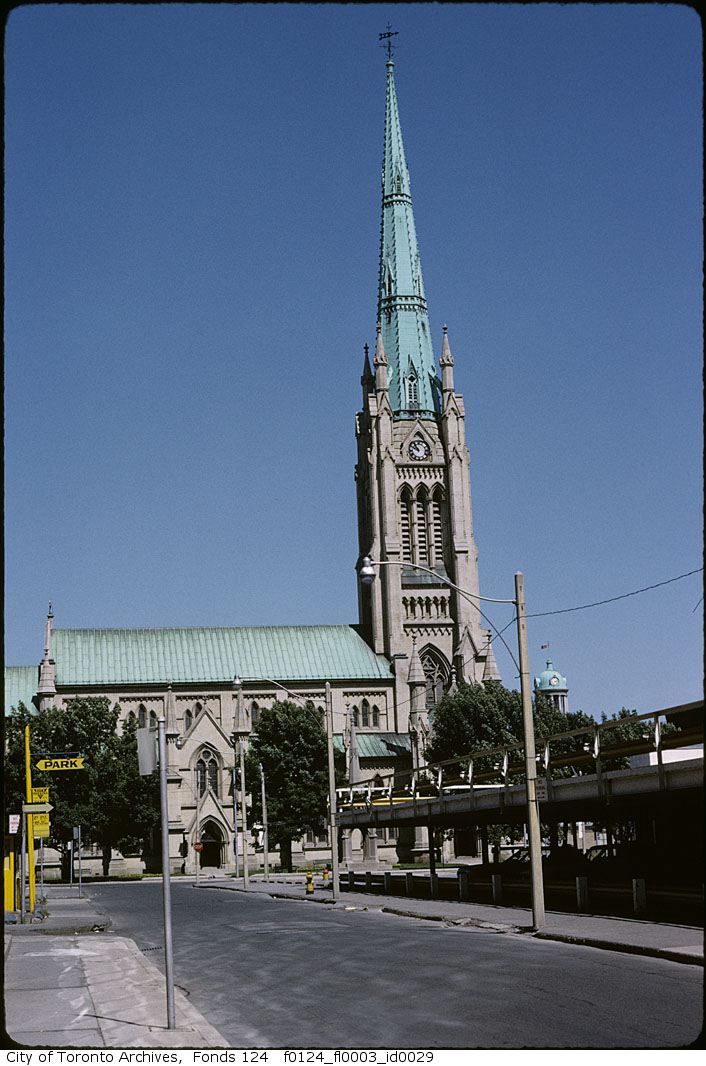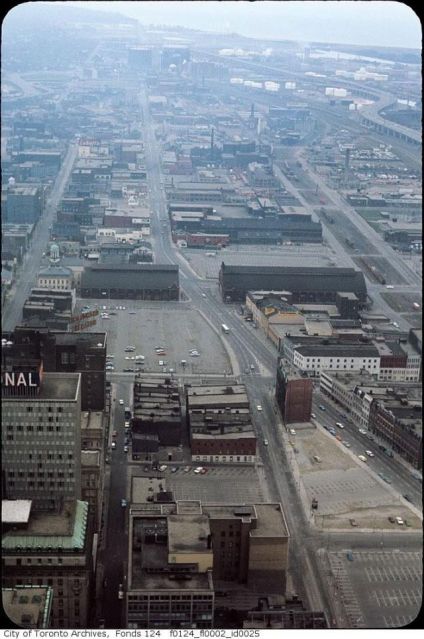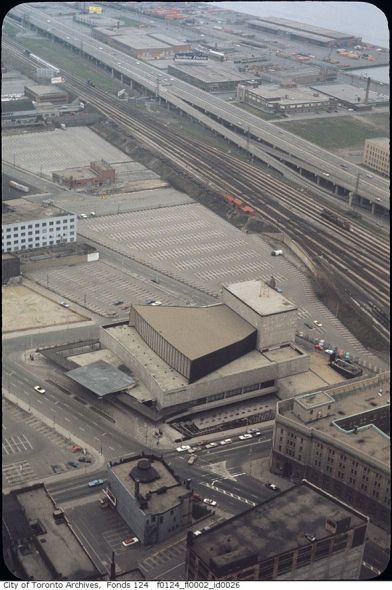|
|
|
You are using an out of date browser. It may not display this or other websites correctly.
You should upgrade or use an alternative browser.
You should upgrade or use an alternative browser.
- Thread starter LowPolygon
- Start date
thecharioteer
Senior Member
Attachments
adma
Superstar
Yeah, I always remember Bloor + Balmuto as the "Belvedere billboard" intersection. (And interesting reminder that 1050 CHUM had already adopted the Cooper Bold by this time)
Conrad Black
Senior Member
Neat shots.
AlbertHWagstaff
Senior Member
Excellent view - looks to be about at least 1957-58 as the Lord Simcoe Hotel is operating and the old Board of Trade building is still standing.
thecharioteer
Senior Member
thecharioteer
Senior Member
Lost King Street: (all from: http://stevemunro.ca/?p=6563)
King east of York (Globe and Mail Building on left):

King and Spadina:

King near Strachan:

King and Bathurst:



King near Simcoe:

King and Church:

PS: This is the building being demolished at King and Church (for a 2-storey parking garage that lasted about 30 years):

King east of York (Globe and Mail Building on left):
King and Spadina:
King near Strachan:
King and Bathurst:
King near Simcoe:
King and Church:
PS: This is the building being demolished at King and Church (for a 2-storey parking garage that lasted about 30 years):

Attachments
Last edited:
fiendishlibrarian
Active Member
Interesting that King and Bathurst wasn't always a grand union, and that the trackage on Spadina south from King was just abruptly cut off with paving and a different track configuration. And the previous pics of Bloor make me wonder if the current Scotiabank branch at Balmuto is still in the same building, only under a mess of stucco and whatnot.
adma
Superstar
King and Church:
View attachment 12039
PS: This is the building being demolished at King and Church (for a 2-storey parking garage that lasted about 30 years):

Actually, any garage here would have been an add-on to what's visible just behind it (Imperial Oil was demolished about 5-10 yrs after the rest of the block). Also, in the first photo, notice the other demolition evidence (i.e. this being when King shopfronts were being cleared for St James Park--and interesting the "dueling demolition companies": Teperman vs Greenspoon)
Worth keeping in mind that I doubt Eric Arthur would, at that time, have especially decried either--the St James Park frontages being deemed "unimportant" relative to a "proper" setting for St James Cathedral, St Lawrence Hall, etc (remember: this was the time when Philadelphia was demolishing big blocks of c19 fabric on behalf of Independence Mall); and Imperial Oil's mini-skyscraper Beaux-Arts was totally unfashionable, the kind of "reactionary" aesthetic that wrecked Louis Sullivan's career before Modernism came to the rescue, bla bla bla.
Oh, and re this
View attachment 12041
Btw/the cyclist and what appear to be a pair of comely young ladies walking by the Massey-Ferguson showroom, there really is a Don Draper-era tension in the air, here...
thecharioteer
Senior Member
Actually, any garage here would have been an add-on to what's visible just behind it (Imperial Oil was demolished about 5-10 yrs after the rest of the block). Also, in the first photo, notice the other demolition evidence (i.e. this being when King shopfronts were being cleared for St James Park--and interesting the "dueling demolition companies": Teperman vs Greenspoon)
Worth keeping in mind that I doubt Eric Arthur would, at that time, have especially decried either--the St James Park frontages being deemed "unimportant" relative to a "proper" setting for St James Cathedral, St Lawrence Hall, etc (remember: this wasllllllkk the time when Philadelphia was demolishing big blocks of c19 fabric on behalf of Independence Mall); and Imperial Oil's mini-skyscraper Beaux-Arts was totally unfashionable, the kind of "reactionary" aesthetic that wrecked Louis Sullivan's career before Modernism came to the rescue, bla bla bla.
..
Quite true, adma, and the clearances for St. James Park, which were done in that Independence Mall mode, should be distinguished what happened on the King/Church/Toronto/Court block (and all the other Front/Wellington blocks between Yonge and Church) which really just amounted to Toronto's version of US-style "urban renewal" which had nothing to do with urban planning and everything to do with creating (among other things) easy parking for the Financial District.

1950:

junctionist
Senior Member
A lot of the demolition on the east side of downtown wasn't just for parking for the Financial District, but in anticipation of the arts district that the city wanted to build, but didn't find the funding for. That's perhaps why so much care was taken into rebuilding St. Lawrence in the 1970s. The ambition was there all along, but the first plan fizzled, and then what was fashionable changed. It should be noted that Jane Jacobs criticized arts districts as pricing out artists from the neighbourhood where the cultural facilities are.
thecharioteer
Senior Member
A lot of the demolition on the east side of downtown wasn't just for parking for the Financial District, but in anticipation of the arts district that the city wanted to build, but didn't find the funding for. That's perhaps why so much care was taken into rebuilding St. Lawrence in the 1970s. The ambition was there all along, but the first plan fizzled, and then what was fashionable changed. It should be noted that Jane Jacobs criticized arts districts as pricing out artists from the neighbourhood where the cultural facilities are.
But admittedly the Blitzkrieg of downtown east went way beyond those blocks earmarked for new cultural facilities:



Last edited:
J T CUNNINGHAM
Senior Member
"But admittedly the Blitzkrieg of downtown east went way beyond those blocks earmarked for new cultural facilities."
QUOTE: Thecharioteer.
I was thinking the term "Clear Cut", would be appropriate, but a book of the same name
CLEARCUT C1997, Gene Threndyle & John Martins - Manteiga
had already taken the title.
Regards,
J T
QUOTE: Thecharioteer.
I was thinking the term "Clear Cut", would be appropriate, but a book of the same name
CLEARCUT C1997, Gene Threndyle & John Martins - Manteiga
had already taken the title.
Regards,
J T
adma
Superstar
A lot of the demolition on the east side of downtown wasn't just for parking for the Financial District, but in anticipation of the arts district that the city wanted to build, but didn't find the funding for. That's perhaps why so much care was taken into rebuilding St. Lawrence in the 1970s. The ambition was there all along, but the first plan fizzled, and then what was fashionable changed. It should be noted that Jane Jacobs criticized arts districts as pricing out artists from the neighbourhood where the cultural facilities are.
Well, it wasn't just about pricing out artists; it was also about pricing out "the proles"--after all, the Jane Jacobs-era Lincoln Center was part of an urban renewal scheme that wiped out the (literal!) scene of "West Side Story". Plus the fact that Lincoln Center-type arrays suffered from the same kind of excessively un-spontaneous and over-institutional planned/zoned thinking that marred so much post-WWII urban renewal (including, for that matter, Independence Mall/St James Park-style urban clear-cutting on behalf of "settings" for insular historic landmarks).
Earlscourt_Lad
Active Member
Well, it wasn't just about pricing out artists; it was also about pricing out "the proles"--after all, the Jane Jacobs-era Lincoln Center was part of an urban renewal scheme that wiped out the (literal!) scene of "West Side Story". Plus the fact that Lincoln Center-type arrays suffered from the same kind of excessively un-spontaneous and over-institutional planned/zoned thinking that marred so much post-WWII urban renewal (including, for that matter, Independence Mall/St James Park-style urban clear-cutting on behalf of "settings" for insular historic landmarks).
It would have been far better, imho, that they had left the storefronts and left St. James in it's urban context. Much in the way that Holy Trinity is enhanced by it's semi-hidden location.

















